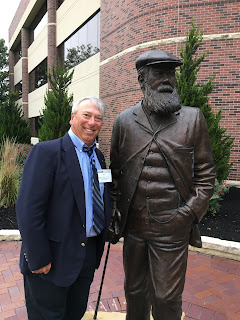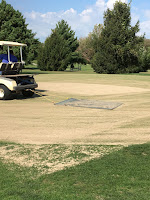As I attempt to be more active with this blog, I thought that maybe I could add one irrigation topic per month or so. Well I don't know if it was perfect timing or dumb luck that yesterday was one of those irritation with irrigation days.
At this time we should take a moment of silence...... for the squirrel who caused a power outage to our pump house.
The poor guy tripped one of these breakers on our power pole leading to the pump house. Luckily we get great customer service from our City Utilities, it was repaired rather quickly, although that didn't quite solve the problem as there was another one of these fuses, (as I call, them, CU has a more technical name for them) popped further down the line. With a little more help from our operations staff and CU, we all figured out other issues in our pump's control panel, and we had water running by late that afternoon.
During that time 2 other staff members fixed 2 heads that had not been working, completing a job I had started the day before. I knew I had 3 heads on our 18th hole not working. So I set out to find those heads and get them on our repair list. They were in our rough area between the blue tee on 18 and the fairway, so there wasn't a huge priority compared to other tasks, but when situations presented themselves we worked to get them repaired.

When I found the 3 heads that had been grass covered and had not been working for a while, they were all sunken below ground level by a fair amount. I edged them to our standard, although edging is usually low on the to do list as much as I would like it to be higher. We have 3 requirements for an edged head, # 1 is the head should be visible for golfers as most would have a yardage tag to let the player know the distance to the green. (Yes I know we have GPS in our carts, but we do have many walkers, especially our juniors who have a fair number of tournaments on our course.) # 2, the head should have grass cleared away to operate properly, and be leveled, and # 3 is for our Rain Bird valve-in heads, we need to have access to the valve key on the side. Prior to edging, none of the standards had been met. Plus the head would not turn on from the control box. After some quick diagnosis with our multi meter, I was able to confirm the issue was the coil on the head.
Since we had enough people cooling off greens on the unusually hot day for late September, I decided to go ahead and at least get one of the heads working. This meant digging up the head to replace the coil, and while I had it dug up, I should go ahead and level the head. For that I had to dig up the swing joint.
The first step was to dig out the coil, (the green part, which when charged with electricity, pulls a internal plunger which allows the valve on the bottom to open and the head to operate. A description that I my words can not do justice, probably a good winter discussion with proper diagrams)
Once exposed I could cut the wires and remove the old coil.
Once removed, the new coil is installed on the head and the wires from the coil are connected to the wires from the control box and held together by wire nuts.
Once that is done, the wire nuts are inserted into plastic tubes containing grease which will keep the moisture out of the connections. Commonly they are referred to as DBY's or DBR's y for yellow wire nuts and r for red wire nuts, of course that makes it easy for me to figure out, but they are also dictated by how many wires one is typically splicing together, the reds will accept more wires.
Once this was done I proceeded to dig out the swing joint so I could level the head. The swing joint allows some flexibility if a piece of equipment were to drive over the head without breaking the head off at the irrigation line. When I was growing up in Florida, I was on a crew that was getting a course ready to open, back in those days, when irrigation heads were installed, they where raised above the ground so when watering in the sprigs of Bermuda, sand would not find its way into the head. We were lowering the heads, and as luck or poor work would have it, our fairway mower, an old Toro Parkmaster ran right over a head we had just lowered and not packed properly snapping the whole head and swing joint off. I never seen a Parkmaster drove in 4th gear on the course before, as the operator drove in to report the geyser.


As the above pictures show, the swing joint allows the head to be adjusted up or down to be level. Resulting in a level head as seen below.
Thanks for reading!
Mel



















































